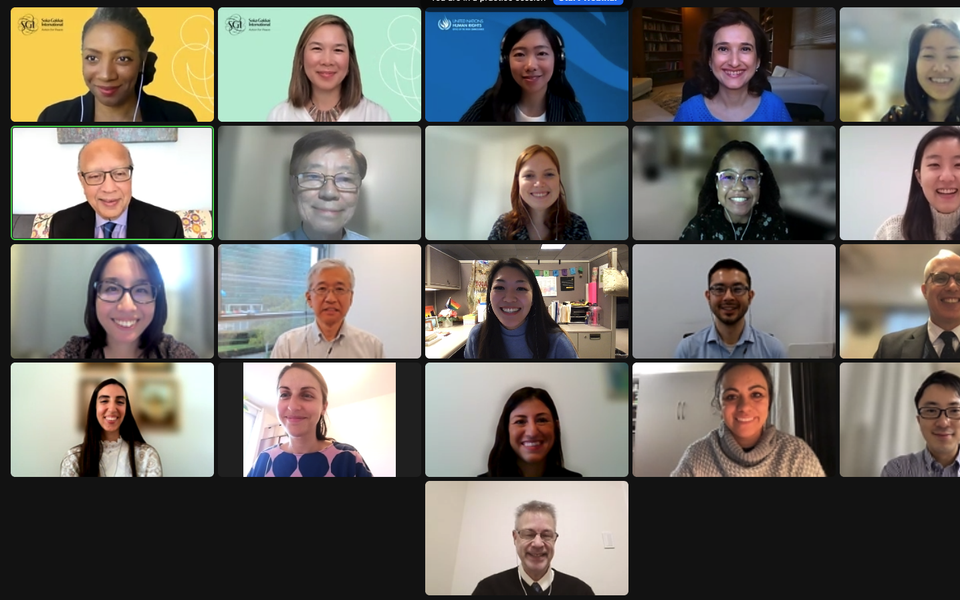
Since 1983, SGI President Daisaku Ikeda has authored peace proposals that integrate philosophical reflections with concrete civic-oriented action steps to point a way forward for everyone seeking to create the global culture of peace. To celebrate the 2022 publication of the 40th proposal, on October 24, 2022, UN Day, the Soka Gakkai International (SGI), working in collaboration with the Ikeda Center for Peace, Learning, and Dialogue, hosted an online panel discussion exploring how the proposals can illuminate and strengthen diverse peacebuilding practices. Called “The Peace Proposals at 40: Creating Vibrant Hope and Advancing the Culture of Peace,” the webinar was attended by nearly 400 people representing 36 countries.
Moderated by Hayley Ramsay-Jones and Ivy Koek of the SGI Office for UN Affairs, the event featured four panelists with unique expertise in global peacebuilding: Alice Ferrario, Education and Youth Coordinator at the SGI-affiliated nuclear abolition organization Senzatomica; Dr. Namrata Sharma, faculty at State University of New York and author, Value-Creating Global Citizenship Education: Engaging Gandhi, Makiguchi, and Ikeda as Examples (2018); Paulina Tandiono, Associate Human Rights Officer at the Office of the High Commissioner for Human Rights (OHCHR); and Dr. Toh Swee-Hin, Professor Emeritus at the University of Alberta and winner of the UNESCO Prize for Peace Education for the year 2000. Adding to the sense of occasion was the special appearance of Ambassador Anwarul K. Chowdhury, who was the Distinguished Special Guest Speaker.
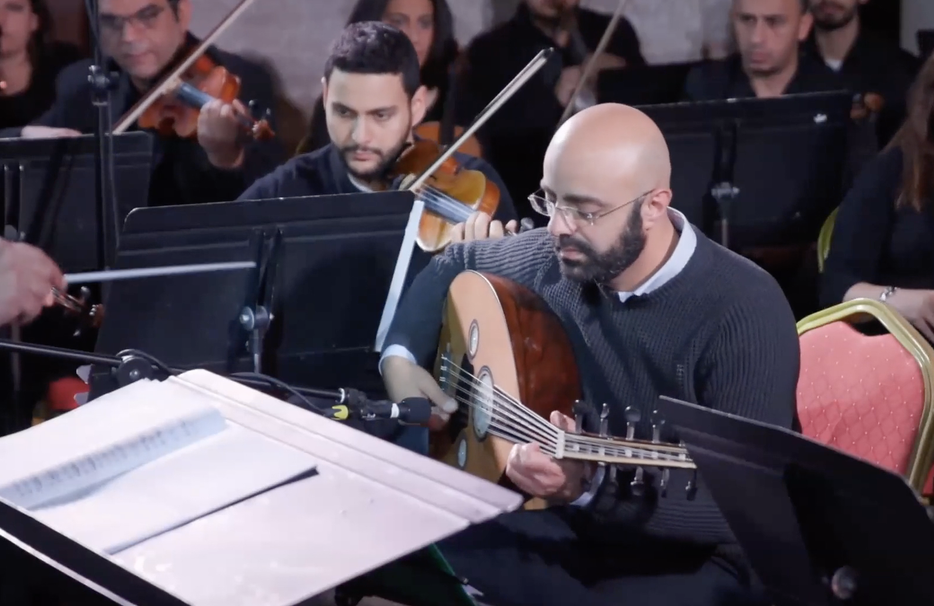
Music performance by the Jordanian composer and oud virtuoso Tareq Aljundi
To activate the peaceful spirit of the presenters and attendees, the program opened with a video music performance by the Jordanian composer and oud virtuoso Tareq Aljundi. Accompanied by a string and percussion ensemble, Aljundi communicated through his playing the deep human compassion that resides at the heart of all successful peacebuilding endeavors.
After the performance, Koek offered some introductory remarks. She first noted how crucial the peace proposals have been for focusing the work that the SGI does as a non-governmental organization consulting with the UN in “areas such as disarmament, sustainability and climate change, human rights education, gender equality and women's empowerment, and humanitarian relief.” She also shared appreciation for Dr. Olivier Urbain, whose research on the proposals has helped illuminate the core themes that run through all the proposals: inner transformation, dialogue, and global citizenship. These themes are “interlinked,” she added, since “inner transformation requires wisdom, courage, and compassion,” the three qualities that Daisaku Ikeda identifies as the “qualities that define global citizenship.” Turning to the title of the webinar, Koek emphasized that in times that seem as “difficult” and “bleak” as these, “we need to create a spark of hope to get us going.” It is hope, she insisted, that provides “the energy to create value,” opening the way to the kind of dialogue that will advance the culture of peace.
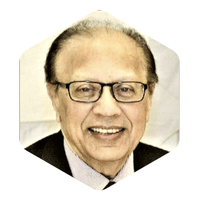
Ambassador Anwarul K. Chowdhury
Former Under-Secretary-General and High Representative of the UN; Founder of the Global Movement for the Culture of Peace (GMCoP)
Opening Remarks from Ambassador Chowdhury
Introducing “our distinguished special guest speaker today,” Koek offered some highlights from Ambassador Chowdhury’s estimable career in international peacebuilding. Permanent Representative of Bangladesh to the UN and a former Under-Secretary-General and High Representative of the UN, he is also founder of the Global Movement for the Culture of Peace. His book-length dialogue with Ikeda, Creating the Culture of Peace: A Clarion Call for Individual and Collective Transformation, was published in 2020. Significantly, added Koek, Ambassador Chowdhury was president of the UN Security Council when it adopted the “groundbreaking” Resolution 1325, a “political and conceptual breakthrough” in the cause of women’s contributions to peace and security. This made perfect sense, suggested Koek, since “above all, he prides himself on being a feminist.” With that, she turned the floor over to the Ambassador.
Thanking Koek for the opportunity to participate, Ambassador Chowdhury shared some well-considered insights on the meaning and importance of the peace proposals, which he described as “having earned the deep admiration of the international community.” Referring back to thoughts he first formulated on the 20th anniversary of the proposals, the Ambassador identified several of the proposals’ most resonant characteristics. On a larger or holistic level, said Chowdhury, “the distinctiveness of the proposals” derives in large part from the way that Ikeda is able to address them “to humanity as a whole” while still being “relevant for the good of every individual human person.” The other key characteristic, he added, is the way the proposals are imbued with Ikeda’s “belief in human capacity and potential ability to overcome the most challenging obstacles.”
In particular, said the Ambassador, the proposals offer four key areas of focus, each of which can be considered in terms of the overall mission of building the culture of peace, the necessity of highlighting women’s peacebuilding contributions, the importance of “humanism as the basis of global civilization.” The four areas focus on:
The centrality of pursuing peace through the nonviolent method of dialogue.
The need to empower regular people, with an emphasis on “the emergence of women” as “active agents in creating peace.”
A commitment to young people as the shapers of the future.
A deep recognition that “the hard power of military force never produces real stability.”
Ambassador Chowdhury also expressed his deep and heartfelt appreciation for Ikeda’s unwavering commitment to the institution of the United Nations. Ikeda’s views on the reform of the UN are especially helpful, said Chowdhury, citing Ikeda’s insight that it is not, as so many skeptics assert today, that the UN is a “powerless institution”; rather, “what is weak is the will of the international community to work together through the United Nations to address global challenges.” To conclude, Ambassador Chowdhury expressed why the peace proposals are so needed today: “The breadth of his vision and the conviction with which he assures us that a bright future is possible, are deeply inspiring at a time when many fear that this new decade is already taking us in a dangerous and downward direction.”
Panel Discussion: The Richness of Peacebuilding
After thanking the Ambassador for his insights, which served, she said, as a “brilliant segue” to the panel, Ramsay-Jones outlined the structure for the discussion. Each speaker would be invited to introduce themselves and their work and then, over the course of the discussion to respond to any or all of four questions: (1) Is there a passage from the peace proposal that resonated with you and how does it connect with your work? (2) From your perspective, what are some of the elements of the culture of peace? (3) What concrete action would you recommend for the UN to live up to its mandate and our expectations? (4) How do you create hope in your work? Note: The following discussion presentation combines key points from all of the panelists’ remarks into a single summary for each.

Alice Ferrario
Senzatomica, Education and Youth Coordinator
Launching the discussion, Alice Ferrario described Senzatomica as “a youth led campaign to spread awareness about nuclear weapons and empower people to create a society free from them.” Crucially, the organization was formed by youth in Italy as an explicit response to the 2009 proposal in which “[Ikeda] encouraged everyone to take action to build global solidarity” in the cause of nuclear abolition. One quote in particular from the proposal inspired them, she said: “[The] enemy is not nuclear weapons per se, nor is it the states that possess or develop them. The real enemy that we must confront is the ways of thinking that justify nuclear weapons—the readiness to annihilate others when they are seen as a threat or as a hindrance to the realization of our objectives.”
In terms of key elements of global peacebuilding endeavors, Ferrario said we do well to pay attention to seminal peace educator Elise Boulding’s insistence that we engage in visioning processes about our shared future that are clear and specific about what a peaceful society actually looks like, in as much detail as possible. In terms of concrete actions for the UN, Ferrario said that we should resist abstraction and maintain an unwavering focus on “respect for life and the needs of every human being” as opposed to only focusing on “nations.” This is why increasing the role of civil society in the UN is so crucial, she said. She also offered five key actions her organization does to promote a sense of hope and possibility for nuclear disarmament among ordinary people. The first is to help individuals see that hope is a “personal decision” and that each of us can begin by “disarming” ourselves. Next, her organization puts “youth at the forefront of our activities.” Third, “we unite people around a common goal.” Fourth, they also seek to engage in dialogue with those who might disagree. Finally, they always share the successes of civil society, including the adoption of the treaty of the prohibition of nuclear weapons at the UN in 2009.

Namrata Sharma
PhD, Faculty State University of New York, Consultant
Namrata Sharma said that in her teaching at the State University of New York and as an independent consultant she focuses on what she describes as “value-creating global citizenship education as a pedagogical approach to learning for sustainability.” She is particularly inspired by the 2014 peace proposal which draws a direct line from “individual empowerment to bold collective actions,” which is the key for both sustainable development and global citizenship. She added that all of her work is informed by the conception of “harmonious coexistence,” which Ikeda described in the 2003 proposal as “a spirit that seeks to encourage mutual flourishing and mutually supportive relationships between humans.” She then moved ahead to the 2022 proposal to highlight another key concept of Ikeda: resilience. “What the world needs most,” wrote Ikeda, “is for governments to work together to develop and forge the kind of resilience that allows us to unite to overcome the severe challenges we all face.”
Drawing on the peace proposal research of “her friend and colleague Olivier Urbain,” Sharma identified three main areas from Ikeda’s writings to take “collective action” to “become inclusive citizens.” First, we need to find ways to get out of our narrow “filter bubbles.” These, she said, restrict us to “views we already hold” and “alienate us from those that think differently than us.” One path out of this trap is to engage dialogically in our “local communities” with “people from diverse perspectives.” The next step is to be creative in actions to help each of us “to fully express our creative self and inner potential,” especially among “girls and women.” Third, is to “engage with the Sustainable Development Goals within our own local and global communities as active citizens.”
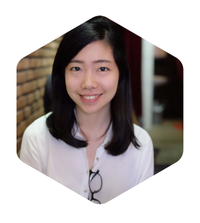
Paulina Tandiono
The Office of the High Commissioner for Human Rights, Associate Human Rights Officer
Speaking from her perspective as a UN human rights officer, Paulina Tandiono said, “I’m particularly intrigued with the question of what are some of the elements of the culture of peace,” as well as “what is our responsibility for creating peace?” Echoing the remarks of others, Tandiono emphasized that the work of human rights is grounded in “strengthening a sense of common values and shared humanity,” adding that “peaceful resolution of conflicts” must be “grounded in the respect for the rights and dignity of others.” Above all, it’s crucial to see these concerns as relevant to the “social, economic, cultural, and political reality of everyday life.” Of human rights education, she said that most of all we should understand it not as an “optional extra,” but rather as “a powerful investment to build a just, peaceful, and sustainable future for all.”
One of the main strengths of the human rights paradigm, said Tandiono, is how it provides a “common language” for “humanity across cultures” and various modes of diversity. Still, when working with young people on human rights education, the OHCHR pursues three strategies. The first is to engage young people, and “people generally,” to engage in activities that encourage them to “think and challenge their own biases, perspectives, and privileges,” and to promote “critical thinking and the exploration of alternative perspectives” so that they can get past default notions that some idea or condition is simply “right or wrong.” Second, the practice of “peer to peer learning” helps young people see that they have unique skills and perspectives to “bring to the table.” Finally, it is essential to create a “safe space” where young people feel they can be honest, since without honesty we can’t truly learn and grow together.
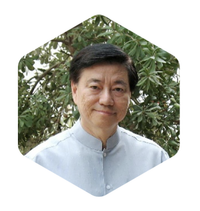
Toh Swee-Hin
Professor Emeritus, University of Alberta
Toh Swee-Hin described himself as a “teacher and teacher educator” who has worked in many “different global South and global North contexts in Asia, Africa, Canada, Australia, and a number of other countries, including in Costa Rica, where I was at the University for Peace.” To open, he offered general reflections on peace and peace education based on both the peace proposals and his own experience. The most fundamental point to make, he said, is that peace is more than “just the absence of war, or direct violence,” both of which are nevertheless essential. Yet, even without war, he explained, children can die “from lack of basic needs” and people of all kinds can “suffer from deprivations” or “human rights violations.”
For this reason, it is wise to always take a “holistic and multidimensional” approach to peacebuilding, something which Toh sees as the core characteristic of the peace proposals. He also indicated his appreciation for Ikeda’s framing question, i.e., “how do we live in a world based on dignity?”—a question that goes to the heart of every instance of inequality and injustice. He also shared the “flower model” for peace education and peacebuilding that he and educators in the Philippines developed. In this model, the flower has six petals. First, is a commitment to creative conflict resolution, with students becoming skilled in nonviolent modes such as negotiation and peer mediation. Second, is the promotion of a true culture of human rights and responsibilities, in which countries “really challenge their own conduct in terms of economic and social rights,” with a willingness to go “beyond the profit motive.” Third, is to take a holistic approach to living with justice and compassion, to “live simply so that others can simply live.” Fourth, is promoting intercultural respect, understanding, and solidarity. At root, this is built on the understanding that “every culture has wisdom.” Fifth, is living in harmony with the earth, which is the heart of sustainable development. Sixth, is cultivating inner peace. Crucially, said Toh, all of these petals are “interconnected and interrelated.”
“I Am a Feminist”: Concluding Reflections from Ambassador Chowdhury
To wrap up the Q&A portion that followed the panel discussion, Ramsay-Jones asked Ambassador Chowdhury to respond to a question “on the role of women in creating the culture of peace. How can we bring more men on board to contribute to gender equality, family cohesiveness, respect for nature, and education towards peaceful communities?” To open, the Ambassador expressed appreciation to the panelists, saying that “you have enriched my understanding of things in a big way.” Responding to Ramsay-Jones, he stated unequivocally that “patriarchy and misogyny” are two of the most “evil” forces “pulling civilization down.” Picking up on the question of how to get men involved, he added that, first of all, “men should understand that equality of women is not just for women.” Indeed, given that they comprise half the population, “how can you marginalize them and dream of progressing?” Further, women’s perspectives and visions have been essential to peace, security, and social harmony “throughout history.” For these reasons, said the Ambassador, it is essential that we move from the scenario of a “table full of men” deciding what’s best for everyone to a society where women are included in decision making. Thus, “feminism is a smart policy that is inclusive, participatory, and doesn’t leave anyone behind.” For these reasons, the Ambassador said he can confidently assert that “I am a feminist.”
Ultimately, said Ambassador Chowdhury, for both feminism and the culture of peace to be truly sustainable, they must be interwoven into “daily existence.” For this to happen, “the seeds of the culture of peace should be sown at the earliest point of life,” from “the fourth or fifth year of the child.” How is this done? We can teach children in the ways of being peaceful. We can encourage them “to respect another person as a human being,” interacting with others nonviolently and “without prejudice, without discrimination.” And we should realize that the culture of peace expands ever outward. It “starts in the family with the parents” and, in extended families, “goes to the grandparents.” Then it goes to “the bigger community” and to “the educational institutions.” Simply put, said the Ambassador, as the child or young person becomes able “to assert his or her culture of peace mindset . . . it will create a ripple effect on the rest of society. He or she can say, I am a nonviolent, peaceful person, and you should be also like that.”
Conclusion: A Spontaneous Action Plan
“I’m so glad we ended on this topic,” said Ivy Koek, as the Ambassador concluded his remarks. This topic of “gender equality” is “one I love,” she said. She then introduced the webinar’s concluding activity, which invited the virtual audience to respond to the question: “How would you like to create hope?” Using the Mentimeter app, attendees added their ideas to a communal list. Start with love for self and others to educate the next generation, said one. Step out of my comfort zone, said another, as the great ideas continued to appear on screen: Listen with empathy. Be a tolerant and loving daughter for my elder mother. Become a beacon of living with and through my difficulties. Speak up for what is right with courage from my heart. Begin with self-transformation.
To wrap up, Hayley Ramsay-Jones said, “I just really want to thank, once again, our panelists for your amazing, amazing contributions. I took a lot personally from it, and really heard the heart of an unwavering peace and unwavering hope.” And it is hope, she concluded, “that is very much what society needs at this moment and is the most courageous act we can give ourselves, our communities, and humanity at large.” She signed off by thanking the Ikeda Center and all the attendees. “I am just very grateful for everyone,” she said, “and look forward to imagining and co-creating more hope and more peace.”
Graphic recording
Joining our webinar was graphic recorder, Adriana Contreras from On the Right Mind, who visually summarized the event in the illustrations below in English, Spanish and French.
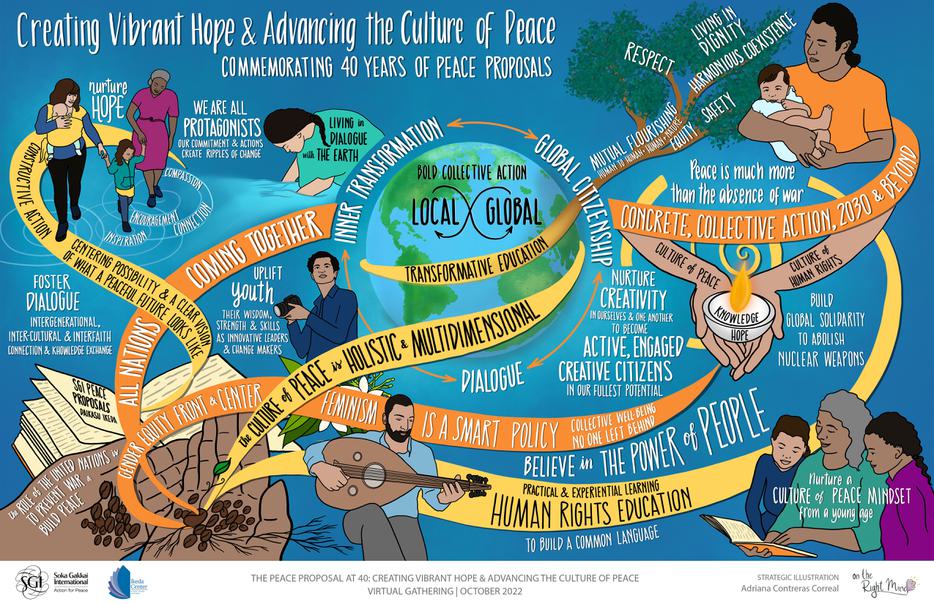
Download PDF version
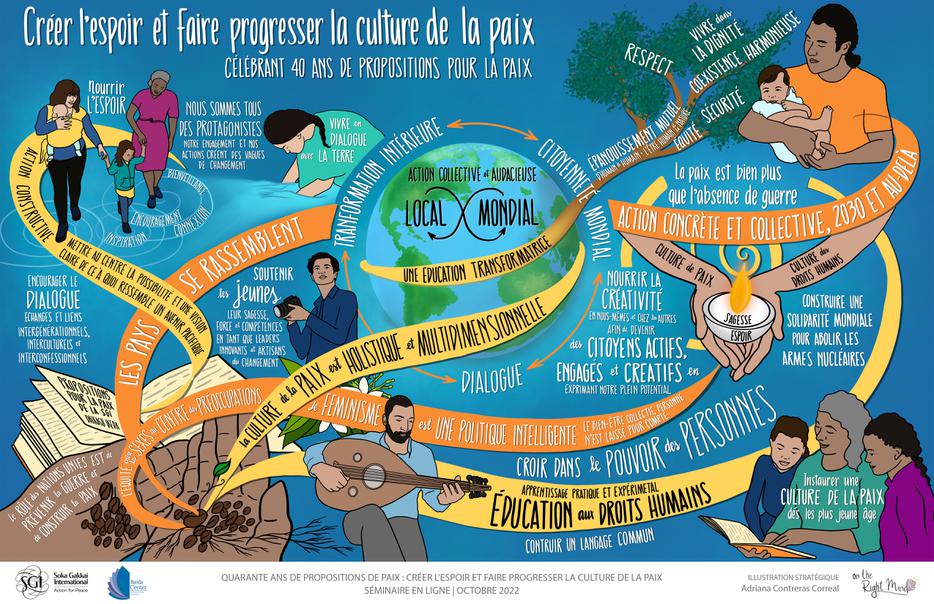
Download PDF version
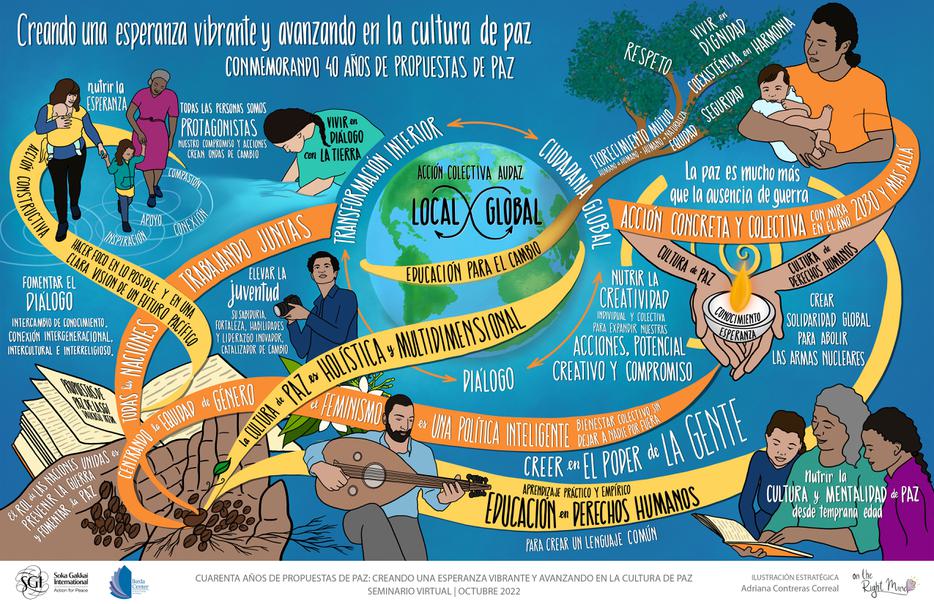
Download PDF version


